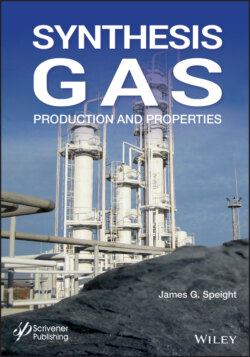Читать книгу Synthesis Gas - James Speight G., James G. Speight - Страница 30
2.2 Synthesis Gas Generation
ОглавлениеThe synthesis gas generation process is a non-catalytic process for producing synthesis gas (principally hydrogen and carbon monoxide) for the ultimate production of high-purity hydrogen from gaseous or liquid hydrocarbon derivatives. In this process, a controlled mixture of preheated feedstock and oxygen is fed to the top of the generator where carbon monoxide and hydrogen emerge as the products.
Soot, produced in this part of the operation, is removed in a water scrubber from the product gas stream and is then extracted from the resulting carbon-water slurry with naphtha and transferred to a fuel oil fraction. The oil-soot mixture is burned in a boiler or recycled to the generator to extinction to eliminate carbon production as part of the process. The soot-free synthesis gas is then charged to a shift converter where the carbon monoxide reacts with steam to form additional hydrogen and carbon dioxide at the stoichiometric rate of 1 mole of hydrogen for every mole of carbon monoxide charged to the converter.
The reactor temperatures vary from 1095 to 1490°C (2000 to 2700°F), while pressures can vary from approximately atmospheric pressure to approximately 2000 psi (13,790 kPa). The process has the capability of producing high-purity hydrogen although the extent of the purification procedure depends upon the use to which the hydrogen is to be put. For example, carbon dioxide can be removed by scrubbing with various alkaline reagents, while carbon monoxide can be removed by washing with liquid nitrogen or, if nitrogen is undesirable in the product, the carbon monoxide should be removed by washing with copper-amine solutions. This particular process (a partial oxidation process) has also been applied to a whole range of liquid feedstocks for hydrogen production. There is now serious consideration being given to hydrogen production by the partial oxidation of solid feedstocks such as crude oil coke (from both delayed and fluid-bed reactors), lignite, and coal, as well as crude oil residua.
The chemistry of the process, using naphthalene as an example, may be simply represented as the selective removal of carbon from the hydrocarbon feedstock and further conversion of a portion of this carbon to hydrogen:
Although these reactions may be represented very simply using equations of this type, the reactions can be complex and result in carbon deposition on parts of the equipment thereby requiring careful inspection of the reactor.
The gasification process is the culmination of five processes: (i) feedstock preparation, (ii) gasification, (iii) steam generation, (iv) air separation, and (v) synthesis gas cleaning, each of which will be described in detail in the subsequent chapters. Briefly, and at this point, a brief mention of the processes is warranted.
The feedstock preparation section will, more than likely, include unit operations such as (i) size reduction, (ii) screening, and (iii) slurrying, the extent of each segment is feedstock dependent and also dependent on the properties of the raw material feed and on the requirements of the gasification technology that is selected.
The gasifier is a reactor for the partial oxidation of the carbon-based raw material to produce raw synthesis gas. This is a high temperature conversion process, and in the gasification zone of the gasifier the temperature is in the range 900 to 1600oC (1650 to 2910oF). The conversion of the raw material feed to synthesis gas is endothermic. Part of the feedstock is completely oxidized to carbon dioxide and water to provide the energy for syngas production. The carbon monoxide, hydrogen, carbon dioxide, and water equilibrate at reaction conditions so that the composition of these compounds in the raw synthesis gas product is governed by the water gas shift equilibrium at outlet conditions. All elements that can be volatilized at the gasification temperature will end up in the raw synthesis gas. For example, if the raw material contained sulfur or nitrogen, the raw synthesis gas will also contain hydrogen sulfide (H2S) and ammonia (NH3). Non-volatilized carbon matter and mineral matter are rejected from the gasification process either as soot, ash, or slag. Another important aspect of gasification is heat recovery, which determines the thermal efficiency of the gasifier.
In the steam generation section, the synthesis gas composition can be manipulated by the ratio of steam to the feedstock that is co-fed to the gasifier. The steam is a source of hydrogen and is essential for feed materials with a low effective hydrogen-to-carbon ratio.
Gasification is a partial oxidation and pure oxygen is usually the most efficient oxidant. It is possible to use air as oxidant, but air should not be considered as an oxidant in a gasification process where the energy is supplied by direct combustion of part of the process feed. When air is mixed with the process feed, a large volume of inert gases, mainly nitrogen, is also introduced to the process. Once the inert gases enter the process stream, they remain in the process stream until after the Fischer-Tropsch process. Thus, most gasification processes require an air separation unit to produce pure oxygen as the oxidant for the gasification process.
The raw synthesis gas produced by the gasifier contains contaminants that are poisons for the Fischer-Tropsch catalyst. Contaminants, such as hydrgoen sulfide and halogenated compounds (that can arise when plastic waste – such as from PVC plastic waste – is part of the feedstock), must be removed from the synthesis gas. It may also be beneficial to remove carbon dioxide and water, depending on the requirements of the design of the Fischer-Tropsch gas loop.
